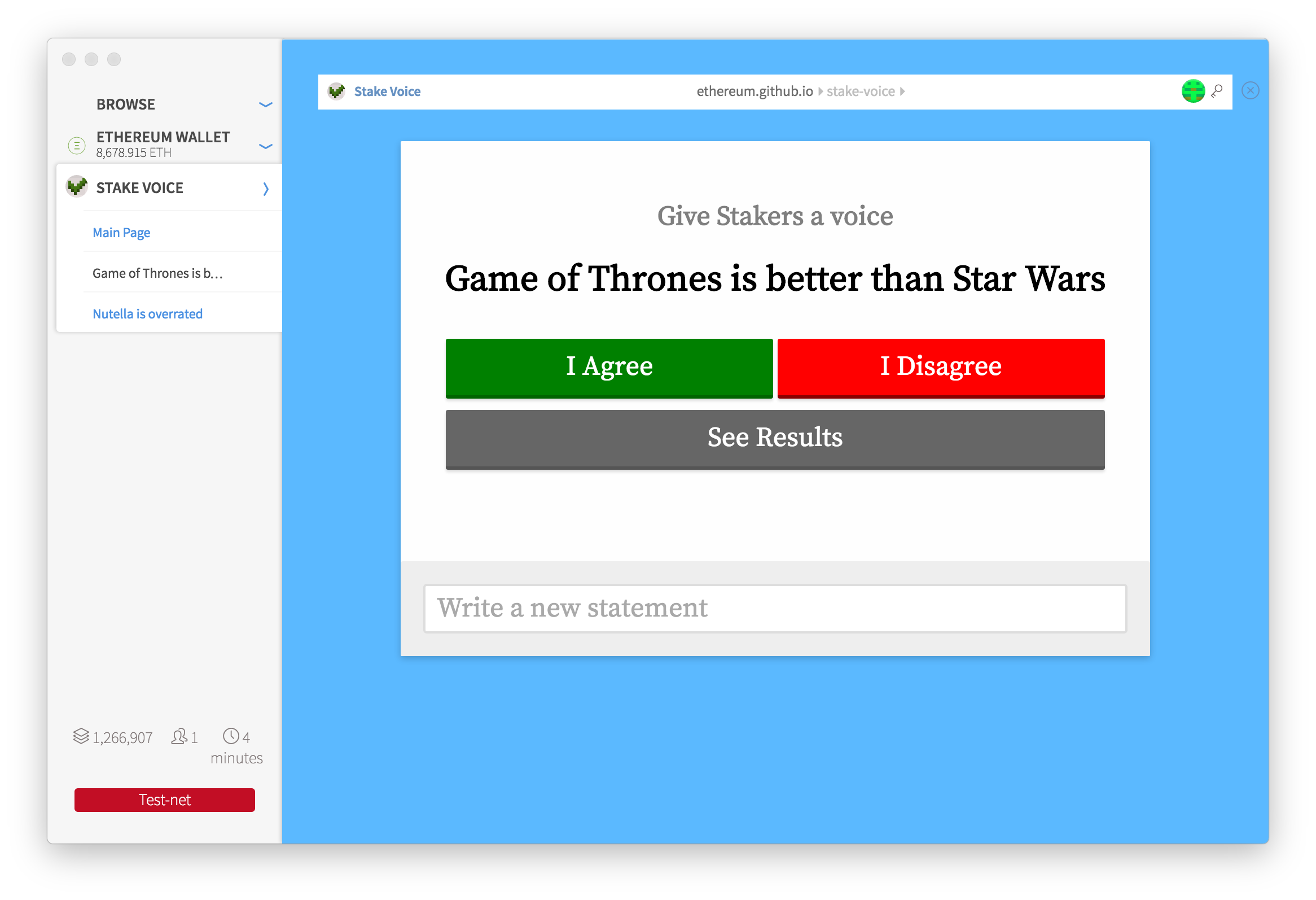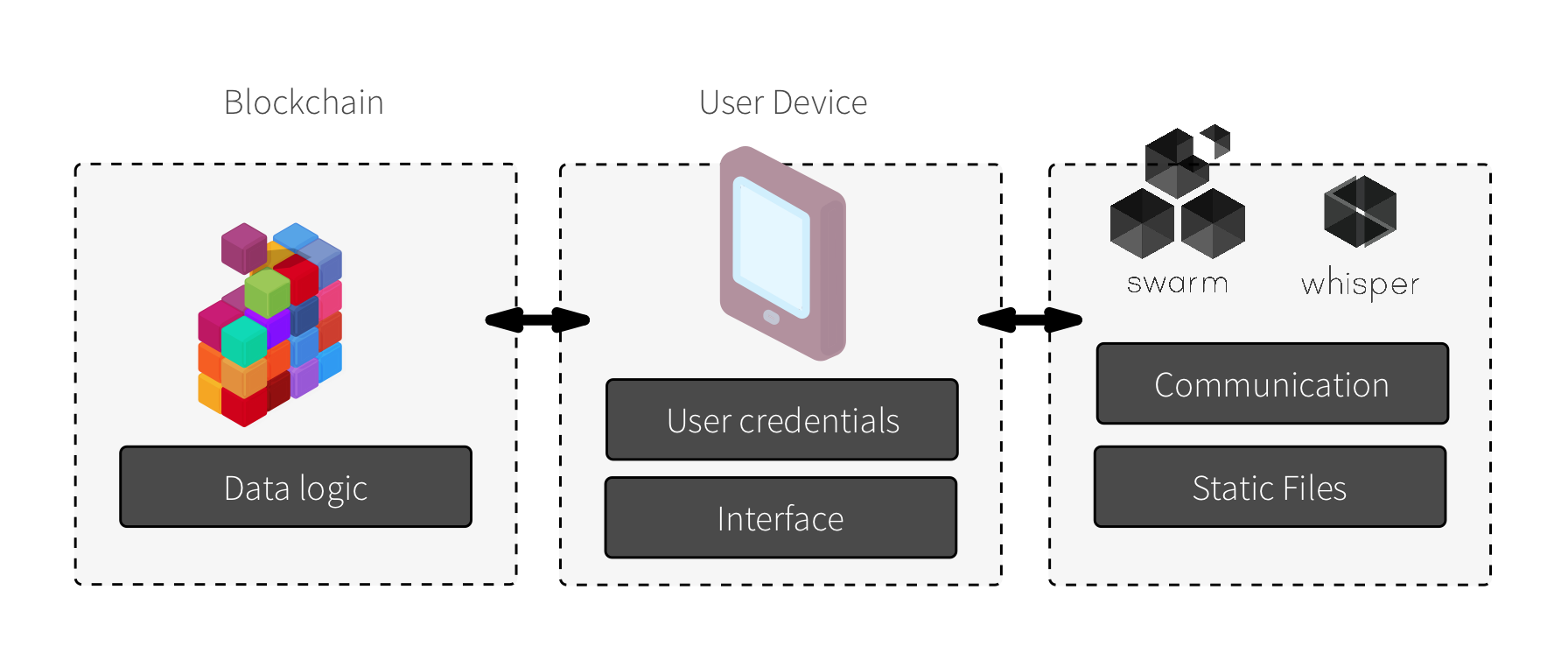

Posted by Alex Van de Sande on July 12, 2016
Ethereum shouldn’t be meant to be a platform to construct esoteric sensible contract purposes that require a STEM diploma to know, but it surely goals to be one pillar of a unique structure for purposes on the world extensive net. With this submit we are going to attempt to elucidate how this may be accomplished and provides some fundamental examples on begin constructing a decentralized app.
Who is that this for?
This textual content is meant at those that have a fundamental understanding of net expertise and construct a easy javascript and html app, and wish to convert these expertise into constructing apps for the Ethereum ecosystem.
How can apps run with out servers?
At the moment servers in net apps do far more than what they had been initially meant to. In addition to serving static net pages, in addition they maintain non-public info, deal with person authentication and cope with all of the sophisticated methods by which knowledge is analyzed and saved. All of the person pc does – a tool which might be thought-about a brilliant pc when the online was invented – is to load and show that info to the person.
As a substitute, a extra decentralized structure would permit a way more modular method, by which completely different machines and completely different protocols would deal with particular duties, some on the person’s facet and a few in specialised machines deployed on a peer to look community. Due to this fact all of the Information logic (what will get saved, who saves it, remedy conflicts and many others) is dealt with by sensible contracts on the blockchain, static information are served through Swarm and realtime communication over Whisper. The person gadget retains the person authentication and runs the appliance interface.
Doing this would take away the hazard of information breach and assaults as there are much less single nodes preserving tons of unencrypted knowledge, whereas additionally eradicating the load and price of serving apps by distributing it throughout the community. Since all these protocols are decentralized, anybody can connect with the community and begin offering a specialised service: if the person is shopping from a strong laptop computer, for example, they’ll additionally serve static information to community neighbors.
A decentralized structure additionally encourages innovation: for the reason that interface is indifferent from the info, anybody can give you a brand new interface to the identical app, making a extra vibrant and competing ecosystem. Arguably, some of the attention-grabbing and progressive durations in Twitter historical past was when it served principally as a central knowledge hub and anybody might construct their Twitter Utility.
See it working
If you wish to experiment with the app earlier than studying it, we suggest you download Mist and read our introductory tutorial to how to install the app and run it. For those who simply wish to see the entire app as an alternative, you’ll be able to obtain it straight from the Stake Voice Github repository.
 Stake Voice working on the Mist Browser
Stake Voice working on the Mist Browser
Let’s get to it
We’re going to construct a quite simple software referred to as “Stake Voice”. The concept is to permit ether stakers to vote on something they need, and the app will tally the overall ether stability of all those that agree or disagree with the assertion.
The app underlying contract is written in Solidity, a javascript-like language and could be very easy:
contract EtherVote { occasion LogVote(bytes32 listed proposalHash, bool professional, deal with addr); perform vote(bytes32 proposalHash, bool professional) { if (msg.worth > 0) throw; LogVote(proposalHash, professional, msg.sender); } perform () { throw; } }
The primary line units up the contract identify and the second creates an occasion referred to as “LogVote”, which can output within the log the next:
- a hash of the proposal being voted on
- if the voter agrees or disagrees with it
- the deal with of the voter
The perform “vote” will then hearth the log, which the appliance later will rely. It additionally has a verify that no ether might be despatched unintentionally. The “nameless” perform is executed when any ether is deposited on the sensible contract and can then routinely reject it.
If you wish to study extra about coding in Solidity we suggest you begin on the ethereum solidity tutorials, learn the official documentation page and take a look at it in your browser utilizing the online compiler.
That is primarily it: you select a hash, select a facet and execute Vote(). So how does this interprets right into a polling app?
Serverless Structure
Following the precept of KISS, we’re doing the minimal product attainable that’s nonetheless usable, which means we cannot be utilizing databases for storing proposals or utilizing any characteristic that requires something aside from vanilla javascript and pure html.
So we are going to use the URL of the app itself to maintain the proposal textual content, and we are going to use that to show it to the person and generate a hash that may then be used to verify the votes. The customers can use social media to share which proposals they wish to debate or just use direct hyperlinks.
// On the preliminary startup perform: proposal = decodeURI(getParameterByName('proposal')); //
Begin with fundamentals
So seize your favourite html framework and get a fundamental web site in your native machine and open it on Mist. All pages in Mist have entry to a javascript object referred to as web3 which can the place you’ll be working probably the most. Very first thing we have to do is verify if web3 is current or not:
Perform init() { ... if(typeof web3 == 'undefined') { // Alert the person they don't seem to be in a web3 appropriate browser return; }
Some software builders would possibly wish to load their very own web3 object, to ensure ahead compatibility. To do this, simply add simply earlier than
tag:
After which add this in your preliminary perform to load your personal customized web3 supplier:
// Checks Web3 help if(typeof web3 !== 'undefined' && typeof Web3 !== 'undefined') { // If there's a web3 library loaded, then make your personal web3 web3 = new Web3(web3.currentProvider); } else if (typeof Web3 !== 'undefined') { // If there isn't then set a supplier web3 = new Web3(new Web3.suppliers.HttpProvider("http://localhost:8545")); } else if(typeof web3 == 'undefined') { // Alert the person he isn't in a web3 appropriate browser return; }
Load info from the blockchain
You checked you might be linked to a blockchain, however which one? Is it the primary ethereum community? Possibly a testnet or a non-public community? Possibly it is a fork sooner or later and your chain is a model new one. The easiest way to verify that is to see if the contract deal with you wish to load has any code on it.
Moreover, to execute a contract it’s essential to know two basic items: it is deal with and the ABI, which will probably be a json encoded file containing interface info.
var contractAddress = '0x1e9d5e4ed8ef31cfece10b4c92c9057f991f36bc'; var contractABI = [{"constant":false,"inputs":[{"name":"proposalHash","type":"bytes32"},{"name":"pro","type":"bool"}],"identify":"vote","outputs":[],"sort":"perform"},{"nameless":false,"inputs":[{"indexed":true,"name":"proposalHash","type":"bytes32"},{"indexed":false,"name":"pro","type":"bool"},{"indexed":false,"name":"addr","type":"address"}],"identify":"LogVote","sort":"occasion"}];
Now that you’ve got these, you’ll be able to verify if the contract exist on the startup perform:
// Load the contract web3.eth.getCode(contractAddress, perform(e, r) { if (!e && r.size > 3) loadContract(); })
You’ll be able to even run this command recursively, to strive connecting to it once more utilizing one other deal with (in case you might be truly on the testnet). After getting discovered your contract you’ll be able to load it up right here:
Perform loadContract() { // load the contract to javascript ethervoteContract = web3.eth.contract(contractABI); ethervote = ethervoteContract.at(contractAddress); }
You’re utilizing the web3 object to create a brand new a javascript object that may have the ability to execute all of the ethereum instructions straight from the browser. If you wish to load solely a single occasion of the contract, then you’ll be able to even do it in a single line:
ethervote = web3.eth.contract(contractABI).at(contractAddress);
Determine the person
Realizing the person’s account reveals loads of details about the person: how a lot ether and some other tokens it has on its stability, and their transaction historical past. So having all apps know this by default would create a brilliant cookie and can be an unacceptable invasion of privateness. Then again, requiring the person to create an person account with login info for every website shouldn’t be solely a ache for the person, but additionally places your non-public info accountable for third events, which creates large honey pots that may be breached by hackers.
As a results of this dilemma most customers have most of their private info and authentication info handled by a half dozen billion dollar corporation. Privateness shouldn’t be a compromise we settle for in trade of practicality: customers ought to have the ability to simply authenticate into any app whereas being accountable for their very own private info.
Utilizing Mist, apps haven’t any details about the person, till the person decides to disclose itself to the app. Once you wish to question what in regards to the accounts, you need to name the getAccounts perform:
web3.eth.getAccounts(perform(e,accounts){ if (!e) { // do one thing with the accounts } });
At the moment, the returning object is an array that holds easy accounts that the person has native entry to, however sooner or later it’s going to additionally maintain sensible contract accounts the person makes use of to determine themselves. This may permit the person to have entry to options presently accessible solely to centralized authenticators, like two issue authentication or cloud backup, and to future enhancements solely accessible to sensible contracts, like permitting a number of trusted buddies to offer you entry to an account for which you misplaced keys or having computerized inheritance of inactive accounts.
Every future Ethereum browser will deal with how customers determine themselves to the App. In Mist we’ve got two methods: both the person can provoke it by clicking the “join” button (presently it is simply referred to as a “no accounts” button) or the App can request the authentication by calling the “requestAccount” api.
Consideration: the accounts on this listing are only one which the person claims to carry the important thing to, however the person has supplied no proof of doing, subsequently you’ll be able to present a unique UI, however do not ship the person any secret info meant solely to that account. For those who require the person to show their id you want them to signal a message, whereas Mist may even help that sooner or later, maintain it in thoughts that it will pressure the person so as to add an additional step and sort their password, so you need to solely use that when completely vital.
Voting
After getting the contract as an object, voting is a matter of calling it from javascript. This may pop up a Mist transaction pane, the place the person will have the ability to verify the transaction after which sort their password. So first we are going to create two clickable objects that calls a vote perform:
doc.getElementById('vote-support').addEventListener('click on', perform(){ vote(true);}, false); doc.getElementById('vote-against').addEventListener('click on', perform(){ vote(false);}, false);
Discover that one calls the perform with a real parameter and the opposite false. The perform vote might be so simple as:
Perform vote() { ethervote.vote(proposalHash, help, {from: web3.eth.accounts[0]}); }
“Ethervote” is the thing we created earlier than, and “vote” is considered one of its features, which correspond to one of many contract features:
perform vote(bytes32 proposalHash, bool professional) {}
We move the 2 parameters demanded by the perform after which add a 3rd object containing transaction informations, like who’s it being despatched from and optionally, how a lot gasoline to incorporate or how a lot to pay for the gasoline.
Consequently this would generate a panel asking the person to substantiate the transaction – however most probably it’s going to return an error as a result of presently the web3.eth.accounts object is an empty array by default, so you need to verify for that and if empty, request the accounts to the person:
perform vote(help) { web3.eth.getAccounts(perform(e,accounts){ // Examine if there are accounts accessible if (!e && accounts && accounts.size > 0) { // Create a dialog requesting the transaction ethervote.vote(proposalHash, help, {from: accounts[0]}) } else { mist.requestAccount(perform(e, account) { if(!e) { // Create a dialog requesting the transaction ethervote.vote(proposalHash, help, {from: account.toLowerCase()}) } }); } }); }
It’s best to solely request an account as soon as the person initiated an motion: pinging a transaction out of nowhere will deservedly irritate the person and doubtless make him shut your app. If we observe abuses from apps utilizing this characteristic, we’d add extra strict necessities to when an alert will present up.
Watch the contract
Lastly, to rely up all of the votes we have to watch the contract occasions and see what votes had been solid. To do this, we’ve got to run this perform as soon as to begin watching the occasions, after we instantiated “ethervote”:
ethervote = web3.eth.contract(contractABI).at(contractAddress); var logVotes = ethervote.LogVote({proposalHash: proposalHash}, {fromBlock: 1800000}); // Wait for the occasions to be loaded logVotes.watch(perform(error, outcome){ if (!error) { // Do one thing at any time when the occasion occurs receivedEvent(outcome); } })
The above code will begin studying all blocks from number one.8M (when the contract was uploaded) onwards after which execute the receivedEvent() perform as soon as for every occasion. Every time a brand new block arrives with an occasion this perform will probably be triggered once more so you will not have to name repeatedly. So what would this perform do?
Var voteMap = {}; Perform receivedEvent(occasion) { // Get the present stability of a voter var bal = Quantity(web3.fromWei(web3.eth.getBalance(occasion.args.addr), "finney")); voteMap[res.args.addr] = {stability: bal, help: occasion.args.professional}; }
From the unique solidity contract, you’ll be able to see that the LogVote occasion comes with three argumenst, proposalHash, Professional and Addr:
occasion LogVote(bytes32 listed proposalHash, bool professional, deal with addr);
So what this perform does is that it’s going to use the perform web3.eth.getBalance to verify the present ether stability of the deal with that voted. All balances at all times return numbers in wei, which is a 1/1000000000000000000 of an ether and isn’t very helpful for this explicit software, so we additionally use one other included web3 perform which converts that to any ether unit we would like. On this case we will probably be utilizing the finney, which is a thousandth of an ether.
Then the perform will save the stability, together with the place of the voter to a map primarily based on the deal with. One benefit of utilizing a map as an alternative of an array is that this may routinely overwrite any earlier details about that very same deal with, so if somebody votes twice, solely their final opinion will probably be saved.
One other factor we might do is determine the person and present them in the event that they voted or not.
// Examine if the present proprietor has already voted and present that on the interface web3.eth.getAccounts(perform(e,accounts){ if (!e && accounts && accounts[0] == res.args.addr) { if (res.args.professional) { // Consumer has voted sure! } else { // Consumer has voted towards! } } });
Tally up the votes
Lastly, we should always add a separate perform to calculate the sums of the votes:
Why will we wish to tally up the votes on a separate perform? As a result of for the reason that vote weight is predicated on the present stability of every account, we should always recalculate the balances at each new block, occasion if we acquired no new occasion. To do that you’ll be able to add this perform that may execute routinely everytime a brand new block arrives:
web3.eth.filter('newest').watch(perform(e, outcome){ if(!e) { calculateVotes(); } });
Lastly, as much as calculating the ultimate tally. Now we have beforehand used eth.getBalance in synchronous mode, the place the app would look ahead to the results of the earlier motion to proceed. Right here, since we might be calling loads of actions each block, we are going to use it in asynchronous mode: you name the node and execute the motion at any time when it replies with out freezing the interface.
var totalPro, totalAgainst, totalVotes; perform calculateVotes() { totalPro = 0; totalAgainst = 0; totalVotes = 0; Object.keys(voteMap).map(perform(a) { // name the perform asynchronously web3.eth.getBalance(a, perform(e,r) { voteMap[a].stability = Quantity(web3.fromWei(r, 'finney')); if (voteMap[a].help) totalPro += parseFloat(voteMap[a].stability); else totalAgainst += parseFloat(voteMap[a].stability); // do one thing cool with the outcomes! }); }); }
As you’ll be able to observe on the code, what the app is doing is looping in every of the voting addresses and getting their stability, and as quickly because it returns, it’s going to both add it to the professional or towards camp and sum the totals.
Just a few additional caveats: when there aren’t any occasions, nothing will probably be returned and votes will not be calculated so you need to add a timeout perform on all features that depend on occasions from the blockchain.
setTimeout(perform(){ // If the app would not reply after a timeout it in all probability has no votes }, 3000);
Now you’ll be able to be at liberty to make use of all of your present webdeveloper foo to work no matter magic you need. Use the numbers to construct a pleasant visualization in 3D or connect with your favourite social media to share the most effective questions.
Mist additionally tries to simplify your code by offering some fundamental navigation and UI strategies. If you would like your app to be header much less and occupy the total peak of the mist app, simply add this to your
tag:
<meta identify="ethereum-dapp-url-bar-style" content material="clear">
And if you wish to use Mist itself to navigate in your app, you should use the Mist.menu object:
for (merchandise of propHistory) { if (merchandise.size > 0 && merchandise != 'null') { mist.menu.add( merchandise ,{ identify: merchandise, place: n++, chosen: merchandise == proposal }, perform(){ window.location.search = '?proposal=' + encodeURI(this.identify); }); } }
One wonderful thing about ethereum is you can increase on this easy contract performance while not having permission: you’ll be able to add all additional performance on separate contracts, preserving each single considered one of them easy and simpler to debug. It additionally means different individuals can use the contracts you created to their very own apps and provides new performance. In the meantime, all of the apps use the identical knowledge and backend.
You’ll be able to play with this app reside hosted on github pages, however this is not the canonical supply of reality, simply one of many many attainable interfaces to it. The identical app may even work as a neighborhood html file in your pc or on an IPFS network and sooner or later will probably be downloaded straight through Mist utilizing Swarm.
Some concepts on how one can strive:
- Create an inventory of presently accessible statements. Anybody can verify them by seeing the sha3 of the proposal textual content, so you do not want permission.
- Create threaded feedback the place customers can reply to statements after which upvote or downvote them, type of like a decentralized stake primarily based Reddit
- As a substitute of (or along with) utilizing ether stability, you should use another ethereum token, like The DAO or Digix Gold to weight your questions in another way. Since all that the unique contract shops is the sender, you’ll be able to verify all balances. Or perhaps you’ll be able to create your personal foreign money that’s primarily based on popularity, karma or another means.















